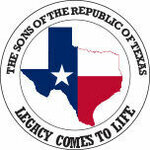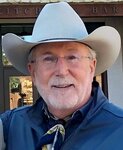

LEGACY COMES TO LIFE
EDITORS NOTE: This is the story of James C. Duff told by Ron Sutton, his great-great-great-grandson. Ron is a member of The Sons of the Republic of Texas (SRT) and serves the David Crockett Chapter as President in Granbury.
My parents are James Duff Jr. and Mary T. Parks. They lived in Hardeman County, Tennessee, when I was born on March 25, 1810. The first things they taught me and all my brothers and sisters were to love God, take care of family and work hard. We all did our best to do exactly what they taught us.
When I was about 15 years old, a family named Bell moved into our area of Tennessee from Kentucky. The Bells had a daughter named Melvina Alvira. She was three years older than me and the prettiest girl I had ever seen. It may have been love at first sight because I started calling her China Bell a short time after we met. I thought that name suited her better than Melvina Alvira.
China Bell and I married on the 18th of August 1829 in Shelby County, Tennessee. I was only 19 years old when we married, but she knew I was a hard worker and would take good care of her and our children. Speaking of children, the first three of our 12 children: Mary, born in 1830; Winnie Jane, 1832; and Marion Jasper, 1833, were born right there in Shelby County. Our fourth child, Maria Catherine Duff, was born in 1836 in Texas. I will tell you more about her a little deeper into my story.
We were doing well in Tennessee, but I was hearing good things about a place called Tejas in northern Mexico. There was a lot of talk about Stephen F. Austin’s Colony and San Felipe de Austin. Seems the 300 families that he settled there had received a lot of land and were prospering. The land was fertile and just about perfect for farming and raising livestock and families. I thought that we could raise a good crop the very first year, and I convinced China Bell the same.
There were rumors of problems that the Mexican government was causing for the Angelo settlers. However, we decided the opportunities outweighed the dangers, and we had confidence that Stephen F. Austin’s second colony would be just as successful as his first one. Therefore, in January of 1834, China Bell and I loaded the kids, along with all our worldly possessions, and headed to Texas.
We first settled in the general area of Columbus on the lower Colorado River. Texas was everything we had heard it was and even more.
The rumors about problems with Mexico turned out to be major trouble. When we made it to Texas, Mr. Austin had gone to Mexico City to calm down the tensions between the settlers and the Mexican government. President Santa Anna even held Mr. Austin in prison for eight months on trumped-up charges of suspicion of inciting insurrection. By the time he returned to Texas in August 1835, we were on the brink of rebellion. We knew the war was inevitable when the Mexican army tried to take a canon from the folks in Gonzales. Right after the Battle of Gonzales, in October of 1835, a general call to arms went out for anyone who could fight for Texas.
I dreaded leaving China Bell and the kids, because there was a chance that I would never see them again. She was almost nine months pregnant, but she said she and the kids would be fine until I got back. China Bell was a strong woman, and she completely supported my decision to fight for our liberty and the liberation of Texas.
March 1, 1836, I joined up with Captain Gibson Kuykendall’s Company of Texian volunteers. Captain Kuykendall was an experienced soldier and cavalry officer before coming to Texas. He made sure we trained for battle every day as time would allow, and we believed we could beat any Mexican army. The captain received orders that we should proceed to San Antonio to reinforce Colonel Travis at the Alamo.
As we approached San Antonio, we met some folks that said the Alamo had fallen and all, but a very few had died. A woman named Susanna Dickinson told us that her husband and every fighting man had been killed. She said Santa Anna had ordered his army to take no prisoners, to kill everyone. Captain Kuykendall decided we best join General Sam Houston as soon as possible.
General Houston had the army camped near the junction of the San Jacinto River and Buffalo Bayou. On April 20, 1836, I was part of a scouting party to gain information about the Mexican army’s activities and location. We were under orders to avoid engaging the enemy if possible. It turned out not to be possible, because we encountered Mexican soldiers that fired on us. I was seriously wounded, and the soldier riding beside me was killed. When we reported back to General Houston, he was concerned that the Mexicans would attack our position very soon. This was one of his considerations for deciding to attack Santa Anna the next day. Our entire army was itching to fight, but my wounds would not permit me to join the battle of San Jacinto on April 21. It was a tremendous victory that ensured our independence from Mexico.
As soon as I could travel, I headed home. What I did not know was the news of the Alamo falling and the massacre at Goliad had already spread back home. China Bell decided the best way to save the children was to flee the Mexican army. She packed up the kids and a few belongings into our small wagon and joined our neighbors in what became known as the “Runaway Scrape.” They all hoped to cross the Sabine River into Louisiana before being captured or killed.
The weather was terribly cold and wet, but I made it home to find it empty. I learned that my family had been gone for about three weeks. I figured as soon as China Bell heard about San Jacinto, she would be heading home. About the middle of May, I had decided it was time to go find her; I heard a wagon coming and kids yelling down the road. I came running out of the cabin, and I cannot express how good it was to see my China Bell and three kids. But she had a surprise for me; our fourth child, Maria Catherine, was born during the Runaway Scrape.
Two of our neighbors and their daughters delivered Maria on May 6, 1836. They took care of China Bell and all four children through the night. One of the neighbors drove our wagon the next day while China Bell rested. She said she did fine, but May 7 was the bumpiest wagon ride of her life.
For my service in the Texian Army, I was issued 640 acres of land in Austin County. In 1845 I was granted 4,427.5 acres in the Colorado District of Fayette County. This property’s patent date was August 21, 1845. We sold the property in Austin County in 1849 and moved to Fayette County, Texas.
China Bell and I agreed that our whole lives had been blessed by the good Lord. Proof of His blessings are our 12 kids and the Great State of Texas. China Bell passed on October 18, 1853, and I followed her August 18, 1869. We are buried next to each other in the Duff Family Cemetery near Praha, Fayette, Texas.
WHO ARE THE SONS OF THE REPUBLIC OF TEXAS? The Sons of the Republic of Texas (SRT) consists of members who are direct lineal descendants of those who settled the Republic of Texas from 1836 to February 19, 1846. The purpose of the SRT is to perpetuate the memory and spirit of the men and women who won Texas’ independence. They set the course for Texas to become a nation and eventually the 28th state. LEGACY COMES TO LIFE personifies our ancestors with true stories about real people who changed the course of history. For membership information, please visit our website: srttexas.org or email: old300.srt@gmail.com.